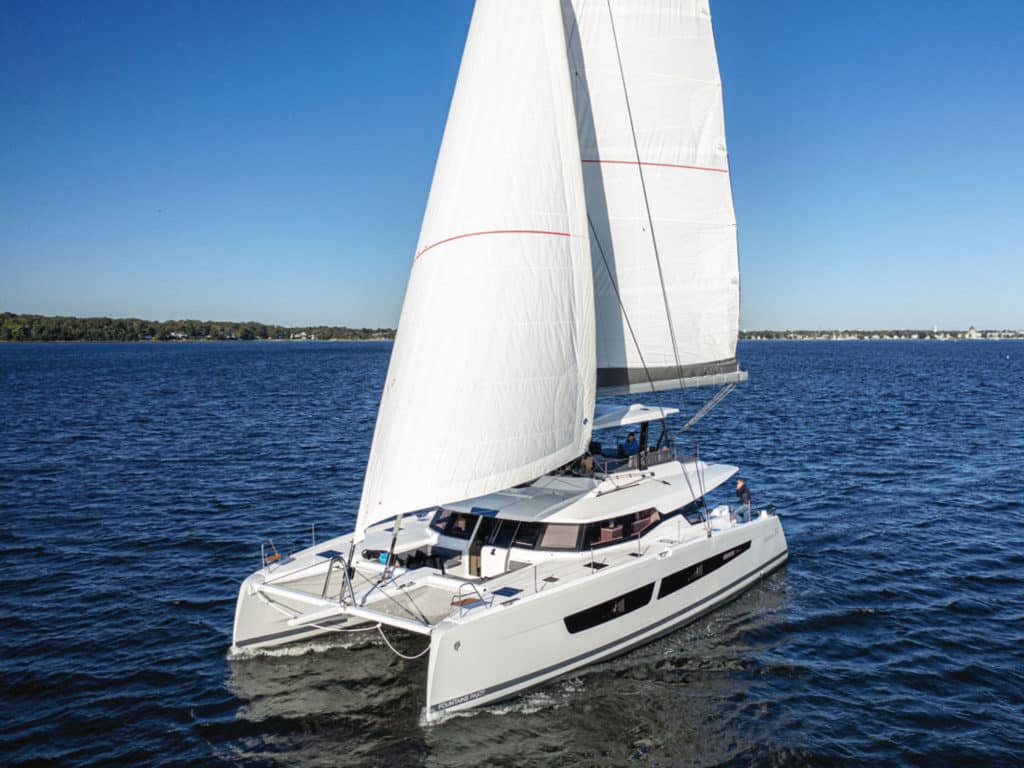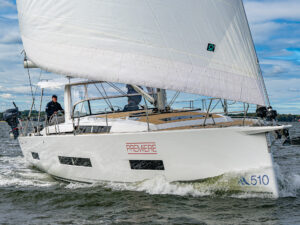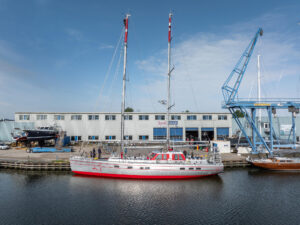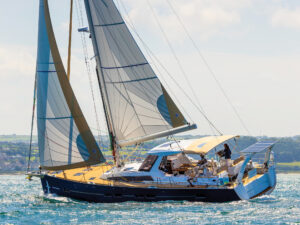
With a length overall of 61 feet, 7 inches and a beam of just over 31 feet, Fountaine Pajot’s Samana 59 is a big boat. As I wandered fore and aft, upstairs and down, while sailing on a sun-splashed morning on Chesapeake Bay with Cruising World’s Boat of the Year judges, I found multiple places to stop and take in the surroundings.
The view from the flybridge was expansive; in the cockpit, the gurgle of the wake passing by was hypnotic. It was a little early in the day to kick back on the foredeck sun cushions, and besides, my feet kept taking me back to the owner’s stateroom in the starboard hull, where an athwartships queen berth sat amidships. Leaning on its edge, I could look directly out the long, rectangular port in the hull and see waves dancing by.
Yep, I thought. That would be the place to be.
Fountaine Pajot is a longtime player in the French catamaran industry. Its more-recent models have tacked in the direction of luxury accommodations, but it hasn’t forgotten its performance roots. Besides looking good, most of the FPs I’ve encountered have sailed well too, the Samana included.
Designed by Berret-Racoupeau—FP’s collaborator for nearly a decade—the Samana has stylish good looks. Its sheer rises from slightly raked-back bows and then tapers downward from the mast aft to the transoms. The lines of the cabin top are repeated in miniature on the Bimini over the flybridge, giving the boat a somewhat space-age look, while displaying the same visual DNA that Olivier Racoupeau employed in the rest of the FP range. The boat we visited in Annapolis, Maryland, all tricked out with gear for the show, carried a price tag of $2.8 million.
On deck, the Samana has a versatile cutter rig with a slightly overlapping jib and large genoa, both set on electric furlers. Upwind, roll out the jib, and coming about is a fairly straightforward chore (with a little help from electric Antal winches). Off the wind, furl the small sail, and deploy the big genoa for more power when reaching. During our test sail, in 9 to 10 knots of breeze, the speedo hovered in the 6-knot range on a reach. Our speed was slightly less than that closehauled—not a big cat’s favorite point of sail. I’d guess that in the Caribbean trade winds, where a boat like the Samana is likely to be found, the ride would be a bit more spirited.
The Samana’s fiberglass hull is resin-infused and balsa-cored for strength and stiffness; the deck and several smaller parts are injection-molded, which gives them a finished look top and bottom. Bulkheads are all cored composite structures and are tabbed to the hulls using fiberglass cloth and resin. Aluminum plates are placed in the laminate wherever hardware is to be installed, and they get drilled and tapped for
assembly.
Living space aboard the Samana is well-thought-out and can accommodate a crowd. The cockpit has a dining table to port and a settee opposite. A second couch spans the transom, with a fridge, grill and sink adjacent to it, to starboard. At anchor, a hydraulic swim platform can be raised for sunbathing or lowered to the water. On the foredeck, there’s more space to kick back on a pair of U-shaped seating areas that can be reached by walking up the wide side decks, or from the saloon, which has a beefy, watertight door front and center.
The boat in Annapolis had what FP calls the Maestro layout, with the galley up in the saloon. Counter space takes up nearly the entire port side of the main cabin, with all the appliances you’d expect to find in a long-legged cruiser. There are multiple fridges and a freezer, and a five-burner stove and oven. The cooking area is open but separated from the rest of the living space by an island with additional counter and stowage.
Opposite is a U-shaped couch surrounding a table that can be raised for dining indoors or lowered for cocktails and coffee. In the forward starboard corner of the saloon, there’s a forward-facing nav station and seat that would be a nifty spot to stand watch when it’s snarly outside.
The Maestro configuration puts the owner’s stateroom in the starboard hull, where it takes up about two-thirds of the space, with sleeping accommodations forward and a head and shower aft. A five-step companionway and hatch provide a private entrance from the deck; a second companionway from the saloon separates the owner’s stateroom from the en suite guest stateroom forward.
A galley-down Maestro version is also available, with the galley replacing the center of three staterooms in the port hull. Access to the aft stateroom is from the cockpit.
There is also a six-stateroom charter version available, giving an owner lots of options for how the boat can be used.
No matter the layout, given the Samana’s size and systems, it is likely that most owners will have a full-time captain and crew, whose quarters are in the forepeaks of both hulls.
For an owner who plans to live aboard and sail, friends and family will find all the comforts of home aboard the Samana. And if chartering is in the plans, pick the layout that will prove the most alluring, and the new FP is bound to be a breadwinner.
Mark Pillsbury is a CW editor-at-large.








